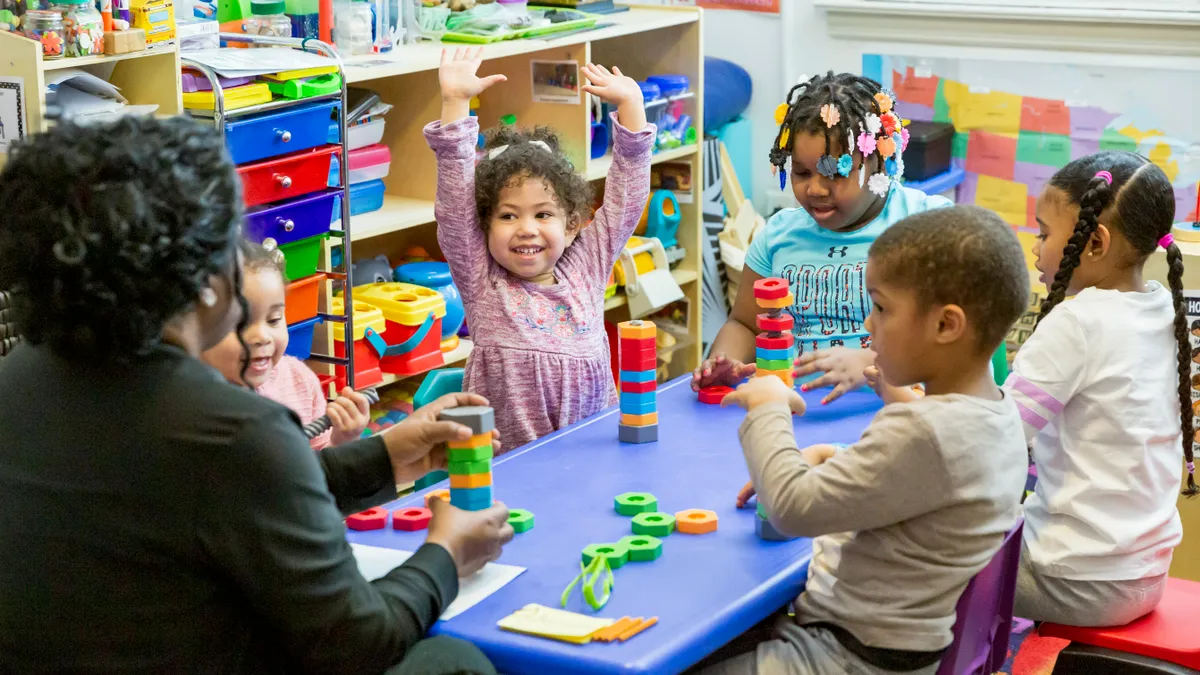UPDATE: June 29, 2021: In a statement emailed to K-12 Dive, U.S. Secretary of Education Miguel Cardona said as the nation turns a corner against COVID-19, "it must be a top priority to reengage every student and family" and "build confidence in returning to in-person learning."
"And it is our responsibility to reengage the families who have been most impacted by this pandemic," he added, pointing to the American Rescue Plan as an avenue to decrease disparities and expand access to high-quality preschool and child care. Cardona has previously expressed support for a return to full-time, in-person instruction in fall.
Dive Brief:
-
Public school enrollment in 2020-21 fell by 3% compared to the previous year, marking the largest decline since the start of this century, according to preliminary data from the U.S. Department of Education's National Center for Education Statistics.
-
As anticipated, the declines were mostly concentrated in pre-k, which saw a 22% decrease, and kindergarten, which experienced a 9% dip. Changes also differed by grade groupings, with a 13% decrease in pre-K and kindergarten, a 3% decrease in grades 1-8, and a slight increase of 0.4% in grades 9-12.
-
Until now, K-12 enrollment had been slowly increasing almost every year since the start of the century, NCES Associate Commissioner for Administrative Data Ross Santy said in a statement. Santy added that changes had been small in the few recent years with enrollment decreases, representing less than 1% of total enrollment.
Dive Insight:
NCES Acting Commissioner Peggy Carr in a statement called the numbers "preliminary but concerning," noting the enrollment decreases were "widespread and affected almost every single state and every region of the country."
Enrollment declines also were especially pronounced for districts that stayed closed longer, Robin Lake, an education researcher and director for the Center on Reinventing Public Education, a nonpartisan think tank, told K-12 Dive previously.
Mississippi and Vermont had the largest declines at 5%, according to the NCES analysis, with Washington, New Mexico, Kentucky, New Hampshire and Maine trailing not far behind at 4% or more.
The District of Columbia, South Dakota and Utah saw the smallest enrollment drops, at less than 1%. Illinois was the only state to not submit data.
The results confirm what researchers had anticipated and feared prior to the data’s release — that enrollment dips may be widespread, significant across grade levels, and especially large in the early grades. The youngest students are also the most difficult, if not impossible, to track, considering pre-K students are not yet in districts' systems.
“Research shows that these early years are essential in helping students succeed academically and socially," said Mark Schneider, director of the Institute of Education Sciences, in a statement. "While it is too soon to say which students were most affected; it is safe to assume that students who struggle the most may be the ones who really lost out.”
Some states plan to invest federal aid from the American Rescue Plan in universal pre-kindergarten, which has the potential to boost low enrollment and bring dollars back into districts.
However, researchers have speculated enrollment declines may only be temporary, a theory bolstered by anecdotal evidence and internal district surveys in some areas.
Polls are showing that a large number of students plan to return and that districts can expect a “flood of young kids” next fall for which they will have to plan space, staffing and funding, Lake said in an interview Monday.
Educators, researchers and public school advocates worried that parents were fleeing traditional public schools for charter or private options during the pandemic. But enrollment in the latter declined on a national level while the number of students enrolled in virtual charters and homeschooling increased, Olivia Rios, associate director of education consulting firm EAB's K-12 division, previously told K-12 Dive.
"The fact that most students have stayed home instead of leaving public school districts for attractive in-person competitors is reassuring for their return — because staying home long-term won’t be viable for most," Rios said, adding that spikes in virtual charter school enrollment are also likely temporary.
And as in previous years, most families who redshirt their children will eventually send them to public school, according to predictions, as keeping them home for several years will be unsustainable and eventually illegal.
NCES plans to release its final findings in spring 2022.
Update: Due to an editing error, this piece originally appeared without a statement providing additional context. The story has been updated to include that context.













